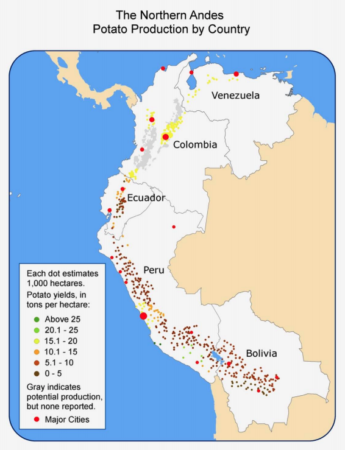- Interactive website on bioclimatic corridors in Mexico. Bits don’t work, though.
- Interactive website on climate analogues for Europe.
- How Andean farmers are coping with the kind of changes mapped above.
- Oh dear, climate smart agriculture is a myth anyway.
- But saving seeds isn’t, thankfully.
- Still not enough linkage with the GIAHS, though, but maybe this course will fix that.
- Maybe start with peafowl? China shows us how.
- How maize became a staple: quite early, and quite quickly, basically.
- Not much coffee in early English coffeehouses. Amsterdam’s coffeeshops unavailable for comment.
- Open-access magnum opus: Conservation Research, Policy and Practice.
Brainfood: Stress, Peasants’ rights, Maize domestication, Plant diversity, Teff evaluation, Red clover diversity, WTP, AnGR cryo, Sheep history, Population & biodiversity, Planet proofing, Cassava map
- Rapid detection of stressed agricultural environments in Africa under climatic change 2000–2050 using agricultural resource indices and a hotspot mapping approach. Even some coldspots will turn hot.
- The UN Declaration on Peasants’ Rights (UNDROP): Is Article 19 on seed rights adequately balancing intellectual property rights and the right to food? What do you think?
- The genetic architecture of the maize progenitor, teosinte, and how it was altered during maize domestication. Domestication worked on lots and lots of really small-effect QTLs.
- Areas of plant diversity — What do we know? Quite a lot, actually.
- Current and projected eco-geographic adaptation and phenotypic diversity of Ethiopian teff (Eragrostis teff) across its cultivation range. Genebank collection thoroughly evaluated. Genebank unavailable for comment.
- Population structure and genetic diversity in red clover (Trifolium pratense L.) germplasm. Genotyping shows 4 geographic groups, with some linked phenotypic differences.
- ‘Warehouse’ or research centre? Analyzing public preferences for conservation, pre-breeding and characterization activities at the Czech genebank. Research centre, but only up to a point.
- Pollen Cryopreservation for Plant Breeding and Genetic Resources Conservation. Gotta wonder what the public preference for conserving pollen might be.
- The recent state of cryopreservation techniques for ex-situ gene conservation and breeding purposes in small ruminants: A review. Oocytes and embryos need more work than pollen.
- Archaeogenetic analysis of Neolithic sheep from Anatolia suggests a complex demographic history since domestication. Domestication bottleneck, followed by diversity increase due to admixture. Too late to cryo, alas.
- A systematic review of biodiversity and demographic change: A misinterpreted relationship? High human population numbers are usually bad for biodiversity, but not everywhere and not always.
- A re-boot of tropical agriculture benefits food production, rural economies, health, social justice and the environment. Plant cool species on degraded farmland. Especially where human population density is high?
- CassavaMap, a fine-resolution disaggregation of cassava production and harvested area in Africa in 2014. Always good to have the next crop production map.
Nibbles: BSF, GNR2020, AI, IITA, Papa, Volcani, Yu, aDNA
- The ITPGRFA’s Benefit Sharing Fund at work.
- Remembering the Global Nutrition Report. Yes, I know it was only a few days ago.
- Measuring poverty from space.
- Interview with IITA’s genebank manager.
- Humble-bragging the potato. In Spanish.
- The Israeli genebank in the news.
- Seed saving in China.
- DNA from ancient Egyptian emmer.
Potato atlas returns to life
I have decided to relaunch the potato and sweetpotato atlas sites — completed while working with CIP, but now personal — in hope that with active collaboration, they can become more current and relevant.
That’s from the very brave Kelly Theisen, on the World Potato Atlas site. We’ll see how both develop, and do what we can to help. The country chapters from the original versions of both atlases, which date back to the 1980’s, are also on there.
Nibbles: 4H, Plague medicine, Maize origins, Rice spread, Seed saving
- Plant Health, Animal Health, Human Health and Environmental Health. What’s not to like?
- It used to be thought that tobacco and sugar could help with the above. Go figure.
- La Cuna del Maíz Mexicano.
- The same, but for rice in Asia.
- Backyard seed saving, and science.
